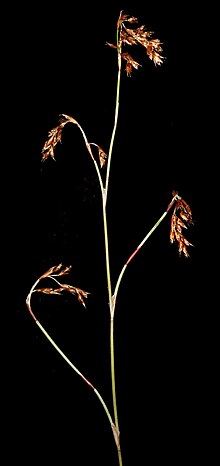bio.wikisort.org - Plant
Leptocarpus coangustatus is a species of plant in the Restionaceae (rush) family, endemic to Western Australia.[1]
| Leptocarpus coangustatus | |
|---|---|
 | |
| Scientific classification | |
| Kingdom: | Plantae |
| Clade: | Tracheophytes |
| Clade: | Angiosperms |
| Clade: | Monocots |
| Clade: | Commelinids |
| Order: | Poales |
| Family: | Restionaceae |
| Genus: | Leptocarpus |
| Species: | L. coangustatus |
| Binomial name | |
| Leptocarpus coangustatus | |
| Synonyms[1] | |
|
Meeboldina coangustata (Nees) B.G.Briggs & L.A.S.Johnson | |
It was first described by Christian Gottfried Daniel Nees von Esenbeck in 1846, from plants collected by J.A.L. Preiss (in the Darling Ranges) and James Drummond (on the Swan River).[2][3] In 1998 Barbara Briggs and Lawrie Johnson transferred the species to the genus, Meeboldina, to give the species name, Meeboldina coangustata.[4][5] However in 2014, the genus Leptocarpus was expanded to include Meeboldina[6] and by 2021 the later name was no longer accepted.[1][2]
References
- "Leptocarpus coangustatus Nees | Plants of the World Online | Kew Science". Plants of the World Online. Retrieved 15 December 2021.
{{cite web}}: CS1 maint: url-status (link) - "Leptocarpus coangustatus". Australian Plant Name Index, IBIS database. Centre for Plant Biodiversity Research, Australian Government.
- Nees von Esenbeck, C.G.D. (1846). "Restiaceae". Plantae Preissianae (in Latin). 2: 65. Wikidata Q110141534.
- "Meeboldina coangustata". Australian Plant Name Index, IBIS database. Centre for Plant Biodiversity Research, Australian Government.
- Barbara Briggs; Lawrence Johnson (21 December 1998). "New combinations arising from a new classification of non-African Restionaceae". Telopea. 8 (1): 30. doi:10.7751/TELOPEA19982011. ISSN 0312-9764. Wikidata Q55801447.
- Barbara G. Briggs (9 April 2014). "Leptocarpus (Restionaceae) enlarged to include Meeboldina and Stenotalis, with new Western Australian species and subgenera". Telopea. 16: 19–41. doi:10.7751/TELOPEA20147400. ISSN 0312-9764. Wikidata Q54554242.
External links
Текст в блоке "Читать" взят с сайта "Википедия" и доступен по лицензии Creative Commons Attribution-ShareAlike; в отдельных случаях могут действовать дополнительные условия.
Другой контент может иметь иную лицензию. Перед использованием материалов сайта WikiSort.org внимательно изучите правила лицензирования конкретных элементов наполнения сайта.
Другой контент может иметь иную лицензию. Перед использованием материалов сайта WikiSort.org внимательно изучите правила лицензирования конкретных элементов наполнения сайта.
2019-2025
WikiSort.org - проект по пересортировке и дополнению контента Википедии
WikiSort.org - проект по пересортировке и дополнению контента Википедии